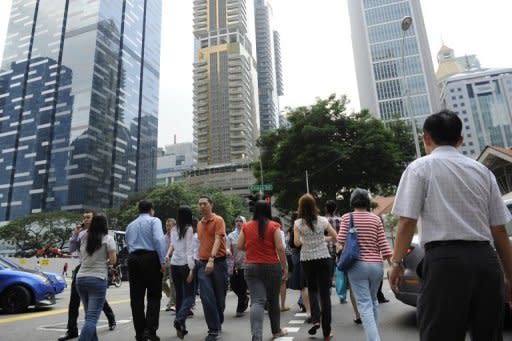New foreign labour curbs to make bad situation worse: SMEs on Budget

Small and medium enterprises expect hiring people will become even harder than how it is now amid the tight labour market after the government announced measures to curb the inflow of foreign workers.
In unveiling measures to help Singaporeans in the government's budget for 2012, Finance Minister Tharman Shanmugaratnam said that to reduce the country's dependence on foreign labour, the ratio of foreigners workers companies can employ will be lowered starting from July this year.
The cap for the manufacturing sector will be brought down to 50 per cent from 65 per cent. For the services sector, the maximum share of foreign workers will be cut to 45 per cent from 50 per cent.
"As it is currently, SMEs are already having some problems... in terms of getting labour, so lowering the dependency ratio (ceiling) would not really help the situation," said Ang Yuit, managing director of IT digital services company The Adventus Consultants.
"If they're looking to kick in by July this year, that's going to be a bit of a challenge for most SMEs," he said. "We are trying to do productivity improvements and so on, but there are limits to how much labour there is. So this is a bit of a concern for us."
In an interview with Yahoo! Singapore, Kurt Wee, vice president of the Association of Small and Medium Enterprises, described measures in trying to help SMEs as "comprehensive", but the downside was the lower dependency-ratio-ceiling (DRC) for the services sector.
"A lot of manufacturing sectors can move overseas or mechanise, but for service sectors a lot of them cannot move. A lot of them are in a very difficult situation. They can't get enough labour, can't get enough to grow," Wee said.
The Singapore Indian Chamber of Commerce & Industry said in a statement that the calibration of the foreign worker caps, the reduction of employment passes and the increase in employer's contribution to the Central Provident Fund for older workers announced "are likely to lead to higher costs for businesses".
According to the Ministry of Manpower, which further outlined the changes announced by Tharman, dependence on foreign manpower has grown by 7.5 per cent per annum over the past two years.
Looking for alternatives
David Sandison, tax partner at auditing PwC Services, said the planned reductions of the dependency ratio ceilings do not appear to be addressing a "dangerously tight labour market".
He said said the proposed measures "will make it more difficult for local businesses, which are starved of appropriately qualified human capital, to meet their resource needs".
He also expressed scepticism over whether measures introduced to encourage employment of older workers will counter-balance the forthcoming restrictions on the employment of foreign workers.
Tharman said SMEs will receive a special credit equivalent to 8 per cent of wages of Singaporean workers above 50 years old and earning up to S$3,000 a month.
"Many of our homemakers and Singaporeans who retired early say they are willing to work, either part-time or full-time," said Tharman, who is also Deputy Prime Minister.
The Singapore Malay Chamber of Commerce and Industry said the incentive to encourage hiring of older workers but the increase in Central Provident Fund rates for them may act as a deterrent.
Adventus' Ang said that there were certain jobs that would not be very well-suited for homemakers or older workers because it would depend on their learning curves.
"If you're talking about industries like engineering and certain aspects of IT and others where you actually need to learn and train for a period of time, this area of tapping into the workforce may not be a good way," he said.
Wee said he hoped that the government would provide exemptions to the lower dependency ratio ceilings on a case-by-case basis for certain industries.
Government is listening
Wee, however, said he welcomed many of the measures targetting SMEs, including providing incentives to hire older workers and enhancements to the Productivity and Innovation Credit (PIC) scheme.
Under the PIC scheme, a 60 per cent cash payout will be made for up to S$100,000 of firms' productivity expenditures, double what government gave previously, and the payout will be made faster, said Tharman.
Wee noted that slow payout had been one of the grouses of SMEs, and the move to address this "shows the government is actually listening".
He also cited the move to expand the coverage of the payouts on expenditures for in-house training and not just external training.
"The fine print shows they are not only looking at the macro they are looking at technicalities of the schemes themselves," Wee said.
Linus Goh, global head of enterprise banking and financial institutions, OCBC Bank, said the budget featured a strong focus on SMEs and provided incentives for making the businesses globally competitive.
"We have seen a three-fold increase in our cross-border SMEs over the last two years. We believe the measures introduced to support the internationalisation of our SMEs will provide a further impetus for this regional growth," he said.
Lau Wah Ming, chief executive officer of Watertech Pte Ltd, an SME that has tapped the assistance of enterprise development agency Spring Singapore, said they are looking forward to details of the government scheme being prepared to help SMEs venture overseas.
"Particularly in the situation of slower growth locally, SMEs who are more adventurous in venturing overseas should be more enthusiastically assisted by both the government and the financial community," he said.
Related Articles:
Singapore to further curb foreign worker inflow
Singapore Budget 2012 roundup
Singapore expects budget surplus for FY2012

